It may be October but there's still time for roses!
Selecting the Perfect English RoseFor a lot of folks, October is pretty much the end of the gardening season and there are only a few cleanup tasks remaining. However, if you’re lucky and live in warmer climes, there’s still time to plant roses and a few other things like garlic and lettuce (which I plan to do this evening, in fact).
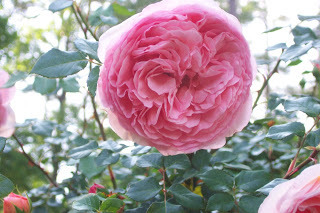 Fall really is the best time to plant roses. It gives them the entire winter to settle into their spot in the garden and prepare for a lovely spring.David Austin’s English Roses are becoming more popular every day since they have a reputation for being easy to care for and bloom fairly freely during the growing season. Unfortunately, many of them don’t always behave and conform to the growth habits promised in Austin’s literature when grown in warmer areas. A good number throw up very, very long canes which can overwhelm a small or medium-sized garden very quickly.From my own personal experiences, I’ve learned to read rose descriptions very carefully and make adjustments for our warmer climate. My local area falls between U.S. zones 7 and 8, where the ground never freezes solid, and I can grow lettuce and radishes under floating row covers during the winter. Roses that grow medium-sized in England are often large here in North Carolina. The varieties listed in this article are older ones, but I wanted to stick to roses that I have grown.The following is a very brief description of a few Austin roses, classed by size, which may be helpful when planning fall purchases. These are roses that I have personal experience with and know can be grown here in coastal North Carolina. Don’t forget: new roses don’t necessarily have to go into the ground if your garden is already full! You can grow beautiful roses in large pots, as well, so you can always find room for one more specimen.
Fall really is the best time to plant roses. It gives them the entire winter to settle into their spot in the garden and prepare for a lovely spring.David Austin’s English Roses are becoming more popular every day since they have a reputation for being easy to care for and bloom fairly freely during the growing season. Unfortunately, many of them don’t always behave and conform to the growth habits promised in Austin’s literature when grown in warmer areas. A good number throw up very, very long canes which can overwhelm a small or medium-sized garden very quickly.From my own personal experiences, I’ve learned to read rose descriptions very carefully and make adjustments for our warmer climate. My local area falls between U.S. zones 7 and 8, where the ground never freezes solid, and I can grow lettuce and radishes under floating row covers during the winter. Roses that grow medium-sized in England are often large here in North Carolina. The varieties listed in this article are older ones, but I wanted to stick to roses that I have grown.The following is a very brief description of a few Austin roses, classed by size, which may be helpful when planning fall purchases. These are roses that I have personal experience with and know can be grown here in coastal North Carolina. Don’t forget: new roses don’t necessarily have to go into the ground if your garden is already full! You can grow beautiful roses in large pots, as well, so you can always find room for one more specimen.
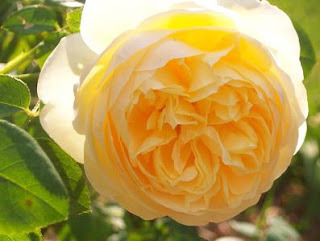 Special note: we’ve discovered that large pots of roses do very well around pool areas, particularly pools used by folks who like to belly-flop or cannonball and splash water everywhere. The reason? The heavily chlorinated pool water lightly splashing the roses seems to cut down on powdery mildew and even black spot! I’m not sure I’d actually spray the roses deliberately with pool water, but the occasional splashing does seem to help.Small Roses
Special note: we’ve discovered that large pots of roses do very well around pool areas, particularly pools used by folks who like to belly-flop or cannonball and splash water everywhere. The reason? The heavily chlorinated pool water lightly splashing the roses seems to cut down on powdery mildew and even black spot! I’m not sure I’d actually spray the roses deliberately with pool water, but the occasional splashing does seem to help.Small Roses These roses will stay small--no more than three feet in height and perhaps that same in width. They will not throw up large canes, so you generally won’t have to worry about cutting them back except to remove dead or diseased wood.v Ambridge Rose (1990); pale apricot pink; fragrantv Charlotte (1993); clear yellow; slightly fragrantv Charles Darwin (2001); tawny yellow; slightly fragrantv Cymbeline (1983); grayish pink; fragrantv Dove (1986); pale pink; fragrantv Immortal Juno (1992); medium pink; fragrantv Mary Rose (1983); medium pink; fragrantv Miss Alice (2001); Light pink; fragrantv Molineux (1994); yellow with apricot tinge to some center petals; fragrantv Noble Antony (1995); wine red; fragrantv Pretty Jessica (1992); medium pink; fragrantv Prospero (1982); deep red with mauve undertones; fragrantv Queen Nefertiti (1988); apricot blend; fragrantv Sharifa Asma (1989); pale pink; richly fragrantv Wife of Bath (1969); warm pink; richly fragrantv Wise Portia (1983); wine-red; fragrant
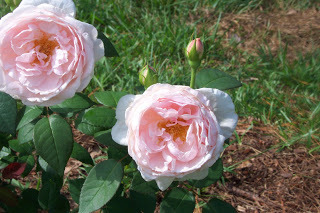 Medium Roses
Medium Roses These roses will grow into medium-sized bushes--no more than five feet in height and smaller in width. They will not throw up large canes, so you generally won’t have to worry about cutting them back except to remove dead or diseased wood, although you may want to trim them back to keep them within the constraints of your garden.v Chaucer (1981); pale pink; fragrantv Golden Celebration (1992); deep yellow; slight fragrantv Hero (1983); clear pink; semi-doublev Lilian Austin (1981); salmon-orange; semi-doublev The Dark Lady (1991); pinkish-red; fragrantv The Nun (1987); white; semi-double (tulip-shaped); slight fragrance
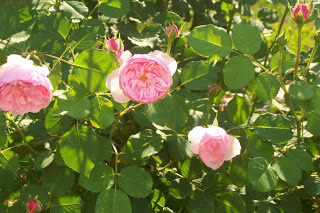 Large Roses
Large Roses These roses will grow into large bushes and can often be used as climbers. They may throw up long canes. Most likely, unless you have a very large garden, you’ll have to train them as a short (8’) climber or trim them back. They make great pillar roses, though, if you want to add height to your garden by placing them in the middle or back.v Abraham Darby (1990); Apricot blend; fragrantv Bow Bells (1994); Medium pink; semi-double (shaped like tulips); slight fragrancev Graham Thomas (1983); deep yellowv Heritage (1984); light pink; fragrantv Jude the Obscure (1995); apricot; fragrantv L.D. Braithewaite (1988); Crimsonv Mayor of Casterbridge (1997); light pink; medium-sized blooms; slight fragrancev Othello (1986); dusky crimsonv St. Swithun (1994); pale pink; very fragrantv Winchester Cathedral (1988); white; fragrant
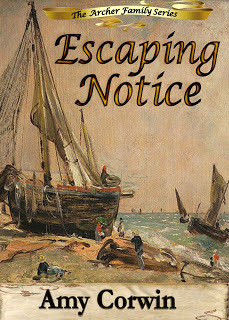 I hope you'll take the time to visit your favorite fall rose garden and smell the roses. The cooler weather really brings out the best in them and rose gardens are great places to relax with a book!
I hope you'll take the time to visit your favorite fall rose garden and smell the roses. The cooler weather really brings out the best in them and rose gardens are great places to relax with a book!Happy Gardening from Amy Corwin, author of Escaping Notice , a Regency romance.Fiction Writing and Other Oddities
Published on October 11, 2012 06:54
No comments have been added yet.



